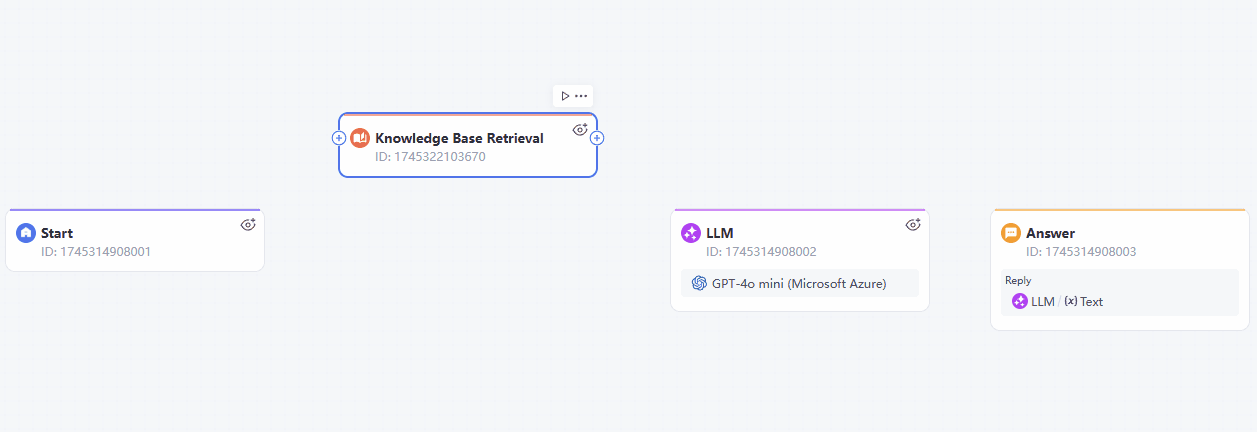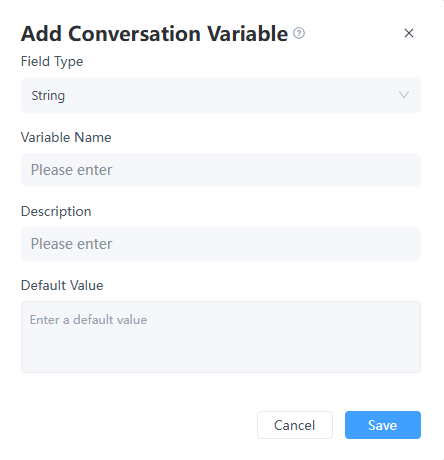1. What is InsightFlow?
In GoInsight.AI, InsightFlow is a no-code solution that allows enterprise users to construct AI workflow automation. It enables users to visually orchestrate various nodes into a seamless and complete process from data collection to execution.
By utilizing InsightFlow, enterprises can efficiently integrate AI capabilities and business logic, automating the entire process to streamline operations and increase efficiency.

Key concept
- Nodes: Nodes are the key components in the workflow, each node is responsible for performing a specific task.
- Variables: Variables are used in workflow to store and transfer data, allowing workflow to share information between different nodes.
Quick Guide:
- Get started: Start with a built-in template.
- Basic configuration: Including create, connect, and configure nodes.
- Test workflow: Debugging workflow, using the checklist to ensure all key configurations are properly set, and viewing debug history.
- Run: Save, publish, and share your workflow.
2. Nodes
There are many built-in nodes in GoInsight.AI platform.
Click and learn more:
-
 Start NodeDetermine the entry of the workflow.
Start NodeDetermine the entry of the workflow.  End NodeDetermine the exit of the workflow.
End NodeDetermine the exit of the workflow. LLMLeverage large language models to process complex natural language output.
LLMLeverage large language models to process complex natural language output. Knowledge Base RetrievalRetrieve relevant information from the internal knowledge base.
Knowledge Base RetrievalRetrieve relevant information from the internal knowledge base. AnswerSet a reply in a chat conversation.
AnswerSet a reply in a chat conversation. AgentAutonomous, able to perceive, reason and utilize tools to accomplish tasks.
AgentAutonomous, able to perceive, reason and utilize tools to accomplish tasks. ProgressOutput the run progress for a workflow.
ProgressOutput the run progress for a workflow. Document ReadRead the document content in the knowledge base.
Document ReadRead the document content in the knowledge base. Document WriteWrite information into a knowledge base document.
Document WriteWrite information into a knowledge base document. HTTP RequestInteract with external APIs/services by sending HTTP requests.
HTTP RequestInteract with external APIs/services by sending HTTP requests. KnowledgeFocus LLMA specialized LLM based on knowledge-base-specific Q&A.
KnowledgeFocus LLMA specialized LLM based on knowledge-base-specific Q&A. IF/ELSEBranches the process based on conditions such as IF, ELSE, etc.
IF/ELSEBranches the process based on conditions such as IF, ELSE, etc. Question ClassifierUse LLMs to perform semantic analysis and categorize text inputs.
Question ClassifierUse LLMs to perform semantic analysis and categorize text inputs. Branch AggregatorCombines outputs from different branches.
Branch AggregatorCombines outputs from different branches. Multi-branch SelectorSelect the corresponding branch to execute subsequent logical operations
Multi-branch SelectorSelect the corresponding branch to execute subsequent logical operations IterationExecutes repeatedly and combines all outputs into a single list.
IterationExecutes repeatedly and combines all outputs into a single list. Auto-ContinueAutomatically proceed to the next round of chat conversation.
Auto-ContinueAutomatically proceed to the next round of chat conversation. TemplateA tool for creating customized text.
TemplateA tool for creating customized text. CodeRun Python code within a workflow
CodeRun Python code within a workflow JSON Variable ExtractorExtract specified fields (values) from input data in JSON format
JSON Variable ExtractorExtract specified fields (values) from input data in JSON format Variable AssignerSet specific values to variables.
Variable AssignerSet specific values to variables. Variable ExtractorAnalyze and interpret natural language input.
Variable ExtractorAnalyze and interpret natural language input. Tool CallInvoke existing tools under the account dynamically.
Tool CallInvoke existing tools under the account dynamically.
3. Variables
Variables can be divided into three different types based on their scope and purpose.
3.1 System Variables
System variables are predefined parameters at the system level and can be accessed by other nodes.
Interactive Flow provides the following system variables:
| Variables | Data Type | Description |
|---|---|---|
| Date | String | The current date when the workflow starts executing, in UTC format of yyyy-MM-dd |
| Time | String | The current time when the workflow starts executing, in UTC format of HH:mm:ss |
| TimeOffset | Number | The difference between UTC and the local time zone. |
| BrowserLang | String | The language setting of the user's browser. |
| Query | String | The current user input or query. |
| $SessionID | String | A unique identifier for the current session. |
| $LastAnswer | String | The last response provided by the system. |
| $Round | Number | In automatically continued conversations, indicate the current interaction round or step in a session. |
| $ChatHistory | Array[Object] | Conversation history in the session, including the number of Q&A tokens. |
| $WorkflowID | String | A unique identifier for the current workflow being executed. |
| $BatchID | String | A unique identifier for the current batch run of a process or workflow. |
Service Flow provides the following system variables:
| Variables | Data Type | Description |
|---|---|---|
| UTCDate | String | The current date when the workflow starts executing, in UTC format of yyyy-MM-dd |
| UTCTime | String | The current time when the workflow starts executing, in UTC format of HH:mm:ss |
| $WorkflowID | String | A unique identifier for the current workflow being executed. |
| $BatchID | String | A unique identifier for the current batch run of a process or workflow. |
3.2 Conversation Variable
Conversation variables are variables used to store and manage data throughout a conversation or session. They help maintain context, track user inputs, and manage the flow of interaction.

3.3 Internal Variable
Internal variables exist only within a workflow and cannot be accessed externally. They store temporary data, intermediate results, or default configuration settings used during execution.
When a workflow is invoked externally, internal variables remain inaccessible and are neither exposed nor passed in.
Leave a Reply.